Wight Conservation - Monthly Diary
|
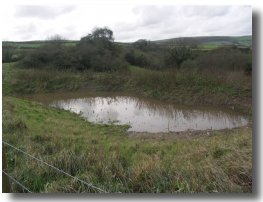
Drainage pond at Wroxall
|
Global warming or a return to normal? I just don’t know. In many respects, the month returned to the Novembers we remember of old. Several hard frosts, when the ice in
the troughs had to be broken up, which we had not been seen for three or four years. At long last the ditches and ponds were full, whereas they had been totally dry for the same period.
Apprehensive of a cold winter, Barry Isaacson sensibly stocked up with feed, oil and salt, and transported hay and straw to strategic points.
CATTLE
|
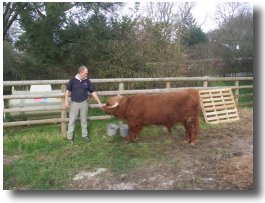
Barry and Cabhlaich 2nd
|
The early part of the month was spent bringing on the two young bulls which we hope to send to the Oban Show and Sale in February. The two year old Isagair of Mottistone, previously halter trained, was groomed, washed and walked out. The six heifers he spent the summer months with will be pregnancy tested in the New Year. Cabhlaich 2nd of Mottistone, a yearling bull but of good conformation, has previously been reluctant and shy. Barry halter trained him and then spent much time grooming, washing and generally making a fuss of him. His outlook has improved beyond all recognition and hopefully within the month we will see a new young bull.
Two yearling heifers, Eilidh 2nd of Mottistone and Lucy of Mottistone, were transferred to Charlie Maclean at Fair Oak in Hampshire. A showman par excellence and one of the most successful showers of Charolais cattle in the country, he is going to bring them on in his spare time, show them in the summer and sell them at Oban in spring 2007. Lucy is a full sister to Isagair.
|

Just before weaning
|
Late in the month Barry weaned all the calves from their dams in the anticipation of them calving again at the beginning of February. It is a difficult task since not only are they weaned but they are also weighed and wormed. On the first day 24 calves from Sandy’s herd were weaned, attended to, and transported to Rew Farm, a large barn about a mile away kindly let to us by David Harvey. They will be out of sight and sound of their dams. In previous years the dams have heard them blaring and consequently demolished the fences in their march to reach them! The next day Rory’s herd, 22 in all, received the same treatment.
The steers averaged 219.25 kg and only one came in at under 200 kg. The heaviest, of Rory’s, was 270 kg. As expected, the heifers came in lighter at 202 kg, but there was a marked difference between Rory’s and Sandy’s stock, the former consistently returning better weights. The only disappoint was the heifer calf by Lord Montagu of Old Greenlaw out of Iseabal 9th of Carsaig, the Champion female we purchased at Oban last February. She weighed in at 185 kg. It was her first calf, and hopefully next year she will produce a better animal, especially as it will be by Rory and she will not have been subject to the stress of the show, sale and transport down from Scotland only two months prior to calving.
It is surprising how busy the life of a stockman is. There are so many activities in addition to the feeding and general husbandry of stock. At the end of this diary, you will read Barry’s own activity diary for the month. There is a surprising wide variety of tasks.
|
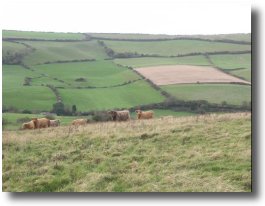
From Wroxall Down
|

From Wroxall Down
|
|
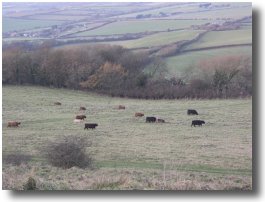
North from St Martin's Down
|
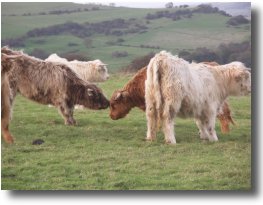
Heifers cleaning each others heads
|
|
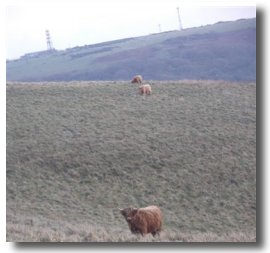
Grazing before sunset on St Martin's Down
|
On Sunday, 6th November, the Rookley Rabbit Hounds visited Wroxall Manor Farm with their Joints Masters Liam Thom and Barry Isaacson. They were accompanied by a field of four people on foot and one mounted. It was pouring with rain but, surprisingly, the rabbits had not all sought refuge in their burrows. They provided useful sport for the dogs. The pack consisted of three terriers, two beagles and two lurchers. They killed four brace. It was particularly interesting to see how they worked together as a
team. The dogs were all getting used to each other. The terriers and the beagles worked the hedges and when they did not either go to ground or kill, the rabbits were pushed out and the lurchers would be waiting on either side in order to finish them off.
Later in the month, the pack visited Coombe Bank near Brighstone and killed a further three brace. The same day the ferreters visited Wroxall Down and took 23 rabbits. Including the Rookley Rabbit Hounds and the Beagles’ visit, and in addition to shooting, a total 45 rabbits were killed in all. Now only 2,000 more to go before we can claim we are making an in-road into their population! It is necessary to control the numbers because although in some areas they usefully graze the grass for conservation purposes, in other areas they are over grazing, and damaging the sword. Last spring on Wroxall Down they almost completely destroyed the displays of Cowslips and Pyramidal Orchids.
Mid month Carolyn and I went to visit Andrew Sallis and Eleasha in France for a short hunting holiday. Andrew was Joint Master and Huntsman of the Isle of Wight Foxhounds for the last two seasons. He has now moved to near Poitiers and organises hunting holidays. The ban apart, it was a well worthwhile
visit www.huntingholidaysinfrance.com
Hunting in France is very different to what we experience here. One can only hunt by invitation of the Masters. It is steeped in tradition. It is all about hounds, venery and tromping (the blowing of their French horns). A spectacular occasion was the day with the Equipage St Laurent hunting roe deer. The meet was preceded by a St Hubert’s High Mass in the town church at Smarves. The church was full with standing room only. There were about 40 hunt members in full hunt livery and 26 trompers playing their horns during the service. Mass was celebrated by no less than three priests and the sermon consisted of the joy to be had by hearing the cry of hounds and the excitement of galloping across country. The singing was of an unusually high standard. The Mass was followed by the blessing of the hounds outside in the rain and then a reception by the Mayor where wine and eats were distributed to all and sundry.
It poured with rain throughout the day, and the hunt came to a successful conclusion just before darkness. The practice is to remove the carcass back to the meet where, when hounds have finished their hunting, the carcass is skinned and then covered with the skin with the head facing towards the assembled company. There is then a tromping ceremony lasting about 30 minutes where the events of the day are played out. Hounds then had their reward.
We had a day hare hunting with the Rallye Neuvillois and another foxhunting, both on foot. The hare hunt was a joint meet and hounds killed their quarry mid afternoon. After unsuccessfully hunting another in a forest, we returned to the meet just before darkness. Curree was again carried out, but this time the hare’s carcass was chopped up with a pile of old French bread to ensure that every hound had its share. After the trumping ceremony, the local farmer invited us all into his hunting barn where, in front of a huge log fire, we were treated to wine and cheese.
Hunts in France appear to be privately owned and they do not have a hunt country in the same way as we do in England. Hounds go to wherever they are invited to hunt, or obtain a licence from the forestry. Deer and hare hounds have to pay for the licence, but the foxhounds do not because the fox is regarded as a pest.
The foxhunting day was another joint meet with a total of 50 hounds to which Andrew added his 5 foxhounds which he had brought with him from the Island. The hounds varied in size from beagles to Andrew’s foxhounds! There was an abundance of foxes, and hounds worked all day in the thickest of undergrowth. The day was all in forestry and because it was so thick hounds did not run away from us. Indeed, the whole day was spent in an area of between 50 and 100 acres.
There was no Field Master with any of the three packs. People could take their own line but there was strict rules that they were not to cross open country on horseback, nor where they to leave the rides in the woods. Discipline is effectively maintained because in order to carry a horn or a hunting whip, it is necessary to pass a state hunting exam which consists of both theory and practical. To be a member of the hunt one has to pass this examine and this entitles you to carry a horn, a hunting crop, and to hunt hounds whenever they are near you and the proper huntsman is not there! A hunting man’s dream!
The French, both urban and rural, are completely unable to understand why hunting was banned in England. The newspapers likened the Labour party to Nazi Germany. I was asked what the Queen thought of the ban. Probably truthfully, I answered that she was disgusted. Hence in the barn afterwards the farmer proposed to the Queen’s health. I responded by proposing the health of President Chirac, to which there was a display of boos, grimaces and long faces!
On 25th November the Countryside Alliance organised the first round of a nationwide quiz. The barn at Wroxall Cross Farm hosted for the Isle of Wight. 13 teams of 6 entered, and each team brought their picnics and drinks with them. Our team, the Wroxall Harriers, was leading until the last round when we were just pipped by the Isle of Wight Foot Beagles.
Dr Jemma Batten, our ecological consultant, made her first visit for about three months and was able to get round most of the areas where she is supervising work. During the autumn we had cleared a further large area at Mottistone Common of Holm Oak and Rhododendrons. She is very pleased with the work carried out by Barry King and at the amount of naturally regenerating heather. The natural process might be slow but it is certainly more effective than importing and distributing heather seeds.
I have my own method of scattering seed. I use a walking stick upside down and slash at the seed heads, scattering the seeds far and wide.
|
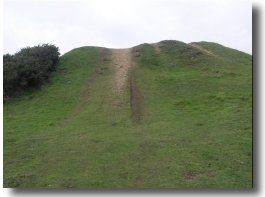
4x4 damage to ancient barrow
|
We drove over Mottistone Down and again Jemma was pleased at the rate of grassland restoration where we had cleared scrub and coppiced gorse. Two success stories! The only blot was more recent damage to an ancient burial mound by a 4x4. Some people believe they have the right to destroy 3,500 years of history.
The third visit was to the heathland restoration on the top of Brighstone Down.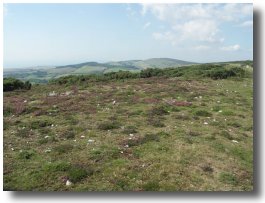 Jemma has very much been the architect of this project and again, she was thrilled with the progress made. Conservation is an art and not a science. Not only are we learning as we go, but, more importantly, we are learning from our mistakes. Jemma has very much been the architect of this project and again, she was thrilled with the progress made. Conservation is an art and not a science. Not only are we learning as we go, but, more importantly, we are learning from our mistakes.
The final stop was at Idlecombe and Rowborough where Jemma showed Barry King the work that was to be carried out when shooting is finished in February.
|
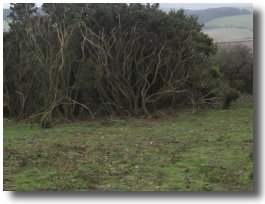
Leggy gorse to be coppiced
|
Over the next two years we are to complete the restoration in the northern sector. Most of the heavy scrub has been removed and we are now concentrating on opening up the large patches of gorse by creating rides and glades through it. We are also coppicing the leggy gorse. Both the chalk heathland and the chalk grassland are naturally restoring themselves well.
Jemma detailed the work to be carried out. Basically it is more of the same but with an increase in the coppicing of the leggy gorse, we should be greatly improving the habitat for birdlife.
The other highlight of the month was the receipt of Graham Sparshott’s ornithological survey at Idlecombe and Rowborough carried out between April and October. It was a very thorough report which will be reproduced on the website within the next few weeks. He identified six birds on the Red List and 16 on the Amber. In all, there were 64 species identified, breeding, non-breeding, migrants and flyovers at the site. His report was encouraging, especially as he believes that the gorse management will lead to the return of both the Stonechat and the Dartford Warbler. The Dartford Warbler was resident there until about two years ago, but as the gorse has grown, so has its habitat reduced.
My woodland work consisted of extensive walks in Rowlands Wood and Wroxall Copse. Both are most beautiful woods but Wroxall Copse is special for its number of veteran trees. Please see the November photo gallery for more photographs of them.
|
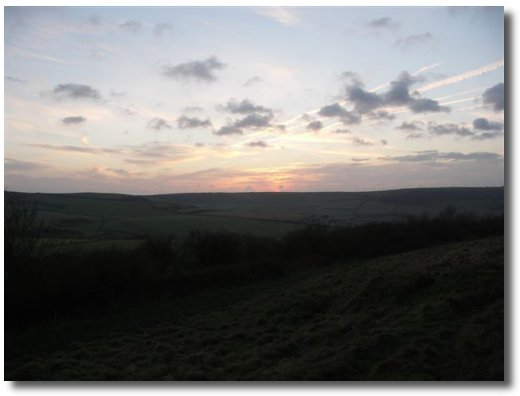
Sunset from St Martin's Down towards Wroxall Down
|
From Barry Isaacson's Diary
| 1st |
Heifer to slaughter
Submersible pump not working
Young bull haltered |
| 2nd |
Repeat halter training
Small bull washed |
| 3rd |
Young bull haltered
3 replacement ear tags ordered
Chased up new pump |
| 4th |
Subbings advise leaks in water system - detected in Grittons
Cleaned up yard
Wired up wooden boundary gate |
| 5th |
Young bull groomed |
| 6th |
Rookley Rabbit Pack – 4 brace |
| 7th |
Groomed and walked small bull
Discussed new drainage ditches behind house
|
| 8th |
2 yearling heifers transported to mainland
Vet trimmed bulls feet, examination to certify as bull
Obtained cattle feed price |
| 9th |
Rang Stubbings regarding tow bar for Ranger 6 x 6
Dug new ditches behind house |
| 10th |
Ordered diesel for next week
Checked fences and water at Idlecombe
Cut up fallen tree in field
Chased up Stubbings re pump
Topper to Hunts for service
Supply 1 round bale hay for horses
Rory escaped from field into old railway tunnel cutting |
| 13th |
Ferreting Wroxall Down – 23 rabbits
Rabbiting Coombe Bank – 3 brace |
| 14th |
Ref-fixed mudguard on hopper tractor
Diesel delivered
Ordered cattle feed
Fixed brown fence at Idlecombe
Put out Magpie trap |
| 15th |
New passport received
Make new Hampshire Gate |
| 16th |
Complete new gateways and attend to fences
Fenced off Quarry
Arranged to use neighbour’s cattle barn |
| 17th |
Heavy frost – broke ice on all water troughs
Hay to Rew Farm & Idlecombe
Sprayed out barn at Rew
Purchased chemicals, rat poison and gloves |
| 18th |
Heavy frost – broke ice on troughs
Chased up cattle feed delivery |
| 19th |
Saw farmer to order straw for Rew Barn
Richard Jackson visits to advise on health status requirements
Collected 145 small straw bales |
| 23rd |
Put out rat bait – Rew and top barn
Water Board rabbit fenced off their boundary |
| 24th |
Obtained 10 bags Rock Salt |
| 25th |
Walked boundaries on potential new farm
Helped prepare barn for CA quiz |
| 26th |
Ferreting Wroxall Down
Neighbour’s cattle escaped! |
| 28th/29th |
Weaned, weighed and wormed 24 calves from Sandy’s herd and moved them to Rew Farm
Transferred dams to Tunnel Butts
Separated large steer and old cow
Moved St Martin’s herd to Grittens |
| 29th |
Weaned, weighed and wormed 22 calves from Rory’s herd and transferred to Rew Farm
Altered layout of Middle Barn
|
Previous Months: September October
|










 Jemma has very much been the architect of this project and again, she was thrilled with the progress made. Conservation is an art and not a science. Not only are we learning as we go, but, more importantly, we are learning from our mistakes.
Jemma has very much been the architect of this project and again, she was thrilled with the progress made. Conservation is an art and not a science. Not only are we learning as we go, but, more importantly, we are learning from our mistakes.
